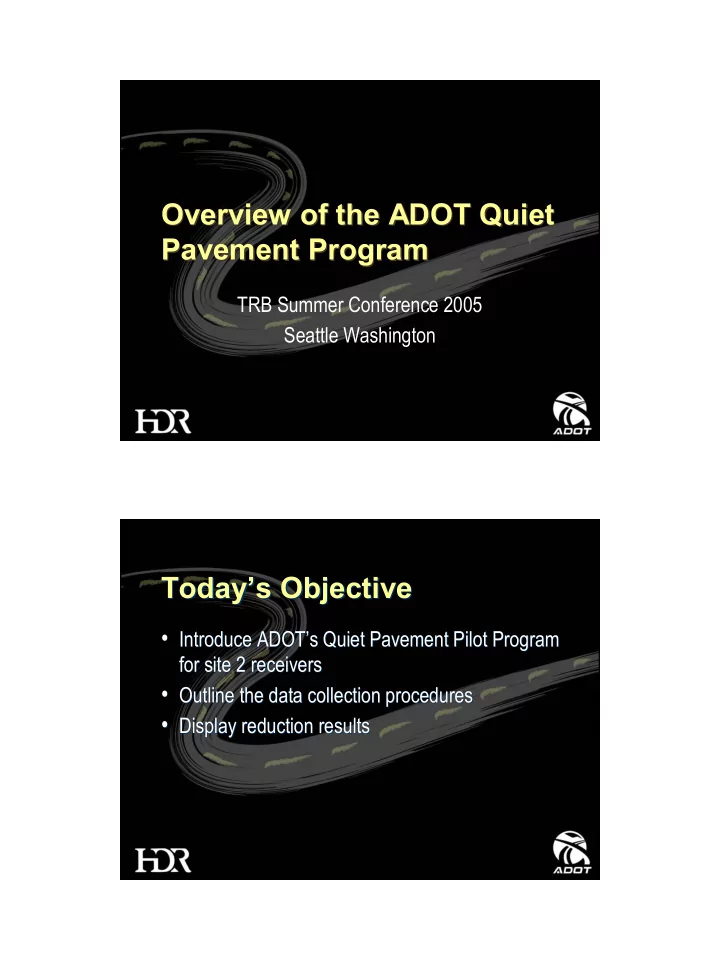

Overview of the ADOT Quiet Overview of the ADOT Quiet Pavement Program Pavement Program TRB Summer Conference 2005 Seattle Washington Today’s Objective Today’s Objective • Introduce ADOT’s Quiet Pavement Pilot Program • Introduce ADOT’s Quiet Pavement Pilot Program for site 2 receivers for site 2 receivers • Outline the data collection procedures • Outline the data collection procedures • Display reduction results • Display reduction results 1
Project Objectives Project Objectives • Ascertain effectiveness of ARFC as noise mitigation • Ascertain effectiveness of ARFC as noise mitigation strategy over time strategy over time • Develop methodology for project • Develop methodology for project • Establish protocol for data collection • Establish protocol for data collection • Select sites along 18 segments • Select sites along 18 segments • Conduct pre- and post-overlay monitoring • Conduct pre- and post-overlay monitoring • Determine reduction in sound level • Determine reduction in sound level • Compile findings in report (in progress) • Compile findings in report (in progress) Project Area Project Area • • Throughout the Phoenix Metropolitan area within Throughout the Phoenix Metropolitan area within Maricopa County Maricopa County • • Covers approximately 115 miles of freeway Covers approximately 115 miles of freeway • • Spans across several cities (Phoenix, Scottsdale, Spans across several cities (Phoenix, Scottsdale, Glendale, Mesa, Tempe, Chandler) Glendale, Mesa, Tempe, Chandler) 2
Regional Freeway System Regional Freeway System Methodology Methodology • “Can rubberized asphalt provide a 4dB reduction • “Can rubberized asphalt provide a 4dB reduction in neighborhoods?” in neighborhoods?” If so… If so… • “Can this reduction be sustained over a period of • “Can this reduction be sustained over a period of time?” time?” And if so… And if so… • For how long? • For how long? 3
Site Selection Site Selection • Representative of residential land uses • Representative of residential land uses • Availability of repeat monitoring • Availability of repeat monitoring • Varying conditions: • Varying conditions: � With and without intervening sound walls � With and without intervening sound walls � Elevated and depressed segments � Elevated and depressed segments � Public facilities (parks, recreation areas) � Public facilities (parks, recreation areas) • When possible residential property was selected • When possible residential property was selected Site 2 Receiver Locations Site 2 Receiver Locations 4
Monitoring Monitoring • 24-hour readings (1 per segment) • 24-hour readings (1 per segment) • Used loudest hour(s) • Used loudest hour(s) • 3 consecutive 20-minute readings at each site • 3 consecutive 20-minute readings at each site • Weather conditions monitored • Weather conditions monitored • Traffic video for counts and speed • Traffic video for counts and speed 24 Hour Reading in DNA 24 Hour Reading in DNA Software Software ARFC Overlay Pilot Program 24-Hour Noise Monitoring September 23, 2003 to September 24, 2003 L101 Pima Freeway - At Cholla Street 80 SPL Running Leq Sliding Leq 70 decibel 60 50 40 5:00:AM 6:00:AM 7:00:AM 8:00:AM 9:00:AM 10:00:AM 11:00:AM 12:00:PM 1:00:PM 2:00:PM 3:00:PM 4:00:PM 5:00:PM 6:00:PM 7:00:PM 8:00:PM 9:00:PM 10:00:PM 11:00:PM 12:00:AM 1:00:AM 2:00:AM 3:00:AM 4:00:AM 5:00:AM time 5
1 Hour Reading in DNA 1 Hour Reading in DNA Software Software Traffic Counts Traffic Counts 6
L101-A-3 Pre-Overlay Post- Adjusted Leq Overlay Leq reduction 64.9 59.1 58.8 I10-H-5 Pre-Overlay Post- Adjusted Leq Overlay Leq reduction 67.8 60.8 60.5 Data Analysis/Reduction Data Analysis/Reduction • • Vehicle equivalents used to compare pre and post Vehicle equivalents used to compare pre and post readings readings Equivalent Vehicles Based on TNM REMELs** NUMBER OF EQUIVALENT VEHICLES Speed km/h (mph) 1 Heavy Truck = 1 medium truck = 1 Automobile = 56 (35) 19.1 7.1 1 64 (40) 15.1 5.8 1 72 (45) 12.9 5.0 1 80 (50) 11.5 4.5 1 88.5 (55) 10.4 4.1 1 97 (60) 9.6 3.7 1 105 (65) 8.9 3.5 1 113 (70) 8.3 3.2 1 ** Based on FHWA Traffic Noise Model (TNM) Reference Energy Mean Emission Levels and vehicle definitions in FHWA-PD-96-008, DOT-VNTSC-FHWA-96-2. 7
Vehicle Equivalents Vehicle Equivalents Calculation Sheet Calculation Sheet Findings to Date Findings to Date • Average reduction exceeds 4dB • Average reduction exceeds 4dB • Public reaction is favorable toward rubberized • Public reaction is favorable toward rubberized asphalt in the Phoenix area asphalt in the Phoenix area Reduction to Date (in decibels) Phase 1 4.9 Phase 2 5.6 Overall 5.3 8
Questions and Answers Questions and Answers 9
Recommend
More recommend